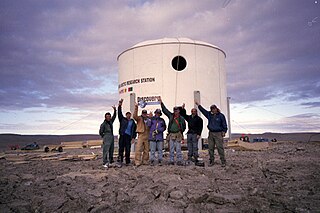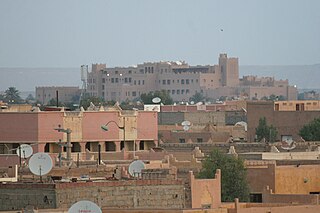PolAres

PolAres [4] was a 2007–2017 interdisciplinary programme of the Austrian Space Forum in cooperation with international partners to develop strategies for human-robotic interaction procedures and to emphasise planetary protection, in preparation for a future human-robotic Mars surface expedition. Part of the PolAres program was developing a Mars analogue space suit. Since 2009 the Mars analogue space suit Aouda.X is developed and tested in several field tests and simulations.
Rio Tinto Simulation 2011
Mars analogue field simulation in Southern Spain in April 2011, together with international experiments including ESA eurobot vehicle. [5]
Dachstein Mars Simulation 2012
A Mars Analogue-Field-test between 27 April and 1 May 2012, together with international partners. The test took place in the mammoth and giant ice caves in the Dachstein Area in Austria. Aside from testing the newest version of the Forum's Spacesuit simulator Aouda.X, teams from 10 different nations (including the US, Europe and New Zealand) tried geophysical techniques, instruments and ideas for future crewed missions to cave systems on Mars. [6] [7]
Mars2013 – Morocco Mars Simulation 2013
Between 1 and 28 February 2013, the Austrian Space Forum – in partnership with the Ibn Battuta Center in Marrakesh – conducted an integrated Mars analogue field simulation in the northern Sahara near Erfoud, Morocco within the framework of the PolAres research programme. Directed by a Mission Support Center in Innsbruck, Austria, a small field crew conducted experiments preparing for future human Mars missions mainly in the fields of engineering, planetary surface operations, astrobiology, geophysics/geology and life sciences. Two space suit simulators (both Aouda.X and the new Aouda.S) and a number of rovers were used in the field. [8]
The desert base camp at the northern location was named Camp Weyprecht on February 11. There was also a satellite location about 80 km further south that was named Station Payer . These names were in honor of the two leaders of the Austro-Hungarian North Pole Expedition of 1872–74, which tied in with the long-term goal of the PolAres research programme to do an analog expedition to the arctic. [9]
AMADEE-15 – Kaunertal Glacier Mission
From August 3 to 15, 2015, a two-week Mars simulation called "AMADEE-15", [10] together with international partners, took place on an ice and boulder glacier in Kaunertal, Austria. Again for this mission, the field crew was supported by a Mission Support Center in Innsbruck, Austria. The experiments conducted covered several disciplines and ranged from geological and astrobiological to robotic and technical experiments. For the first time, this mission also included virtual exploration. The analog astronaut moved around on a simulation platform wearing video goggles and, like the other test astronauts, was in radio contact with mission control. The procedure (V-ERAS) was developed by the Italian Mars Society.
Scientific publications on this Mars simulation:
- Lichenometry and Schmidt hammer tests in the Kaunertal glacier foreland (Ötztal Alps) during the AMADEE-15 Mars Mission Simulation
- C. Markovski, J.M. Byrne, E. Lalla, A.D. Lozano-Gorrín, G. Klingelhöfer, F. Rull, A. Kappler, T. Hoffmann, C. Schröder: Abiotic versus biotic iron mineral transformation studied by a miniaturized backscattering Mössbauer spectrometer (MIMOS II), X-ray diffraction and Raman spectroscopy. In: Icarus. Band 296, Nummer, 2017, S. 49–58, doi : 10.1016/j.icarus.2017.05.017.
- Gernot Groemer, Anna Losiak, Alexander Soucek, Clemens Plank, Laura Zanardini, Nina Sejkora, Sebastian Sams: The AMADEE-15 Mars simulation. In: Acta Astronautica. Band 129, Nummer, 2016, S. 277–290, doi : 10.1016/j.actaastro.2016.09.022.










